The importance of biodiversity in achieving net zero
Protecting the natural world is an important component in achieving net zero.
02/07/2022
Managing our landscapes, from individual gardens to vast areas of native woodlands and peatlands, is vital for sequestering and storing carbon while also increasing and protecting the biodiversity of our plants and animals. A recent study by Natural England has shown that a hectare of woodland sequesters as much carbon dioxide (CO2) each year as 13 flights between London and Rome.
At BGS, we have been creating meadows from our former lawns and, by maintaining native trees in small patches of woodland, we are contributing to carbon sequestering.

Long-tailed tit in the trees around the BGS Keyworth campus. BGS © UKRI.
Our Keyworth site, located on the outskirts of Nottingham, was highlighted as a prime place to manage one of our estate’s landscapes and return the area to a more natural state. Our grassland areas are now 80 per cent ‘no mow’ between April and October, after a recent survey of these areas showed we have many ‘old’ meadow plants, including bee orchids. Various patches of the site have been left to go completely wild and now hundreds of small native trees (hawthorn; blackthorn; holly, etc.) have popped up between the large established trees, while the undergrowth is a mass of brambles and nettles, which is great for butterflies and bees.
Other initiatives to increase our biodiversity include:
- maintaining a pond, which is filled from rainwater diverted from a nearby roof
- installing 60 bird boxes for small birds and owls
- adding several hedgehog boxes
- planting an orchard with twelve apple and pear trees, which will bear fruit for staff and insects in the next couple of years
- establishing three large bug hotels and several bee mounds in our newly created orchard for our smaller guests (insects, mice, voles and shrews)

The BGS site is full of different initiatives promoting local biodiversity, such as this bug hotel made from recycled materials. BGS © UKRI.
In one sunny space, we recently removed and chipped several Leylandii, thus creating an place that is desirable to our local grass snakes. The space includes a large, warm compost area, swathes of heat-absorbing wood chip and rock caves built from waste rock-core material.
To celebrate the Queen’s Jubilee we created a walkway of Japanese cherry trees. While not native, these cherry trees will provide nectar early in the season to feed early-emerging bees and other insects. We have planted thousands of spring bulbs including bluebells, snowdrops, wild garlic and daffodils. The Keyworth grounds have also been enhanced with wild-flower circles; the ox-eye daisies have looked particularly amazing through June.

Ox-eye daisies blooming in the grounds of BGS Keyworth. BGS © UKRI.
The BGS Keyworth site is a good example of how, by changing the management of the grounds, we are helping to sequester carbon as well as reaping multiple other benefits. We save money by reducing our gardening costs, improve the health of our plants and animals, and the beautiful grounds are admired by our staff and encourage lunchtime walks, which supports the health and well-being of both staff and visitors.
About the author

Prof Melanie Leng
BGS Chief Scientist, environmental change, adaptation and resilience
Relative topics
Latest blogs

AI and Earth observation: BGS visits the European Space Agency
02/07/2025
The newest artificial intelligence for earth science: how ESA and NASA are using AI to understand our planet.

Geology sans frontières
24/04/2025
Geology doesn’t stop at international borders, so BGS is working with neighbouring geological surveys and research institutes to solve common problems with the geology they share.

Celebrating 20 years of virtual reality innovation at BGS
08/04/2025
Twenty years after its installation, BGS Visualisation Systems lead Bruce Napier reflects on our cutting-edge virtual reality suite and looks forward to new possibilities.

Exploring Scotland’s hidden energy potential with geology and geophysics: fieldwork in the Cairngorms
31/03/2025
BUFI student Innes Campbell discusses his research on Scotland’s radiothermal granites and how a fieldtrip with BGS helped further explore the subject.

Could underground disposal of carbon dioxide help to reduce India’s emissions?
28/01/2025
BGS geologists have partnered with research institutes in India to explore the potential for carbon capture and storage, with an emphasis on storage.

Carbon and oxygen isotope analysis of carbonates and the development of new reference materials
18/12/2024
Dr Charlotte Hipkiss and Kotryna Savickaite explore the importance of standard analysis when testing carbon and oxygen samples.

Studying oxygen isotopes in sediments from Rutland Water Nature Reserve
20/11/2024
Chris Bengt visited Rutland Water as part of a project to determine human impact and environmental change in lake sediments.

Celebrating 25 years of technical excellence at the BGS Inorganic Geochemistry Facility
08/11/2024
The ISO/IEC 17025 accreditation is evidence of technical excellence and reliability, and a mark of quality assurance.

Electromagnetic geophysics in Japan: a conference experience
23/10/2024
Juliane Huebert took in the fascinating sights of Beppu, Japan, while at a geophysics conference that uses electromagnetic fields to look deep into the Earth and beyond.

Exploring the role of stable isotope geochemistry in nuclear forensics
09/10/2024
Paulina Baranowska introduces her PhD research investigating the use of oxygen isotopes as a nuclear forensic signature.

BGS collaborates with Icelandic colleagues to assess windfarm suitability
03/10/2024
Iceland’s offshore geology, geomorphology and climate present all the elements required for renewable energy resources.

Mining sand sustainably in The Gambia
17/09/2024
BGS geologists Tom Bide and Clive Mitchell travelled to The Gambia as part of our ongoing work aiming to reduce the impact of sand mining.



